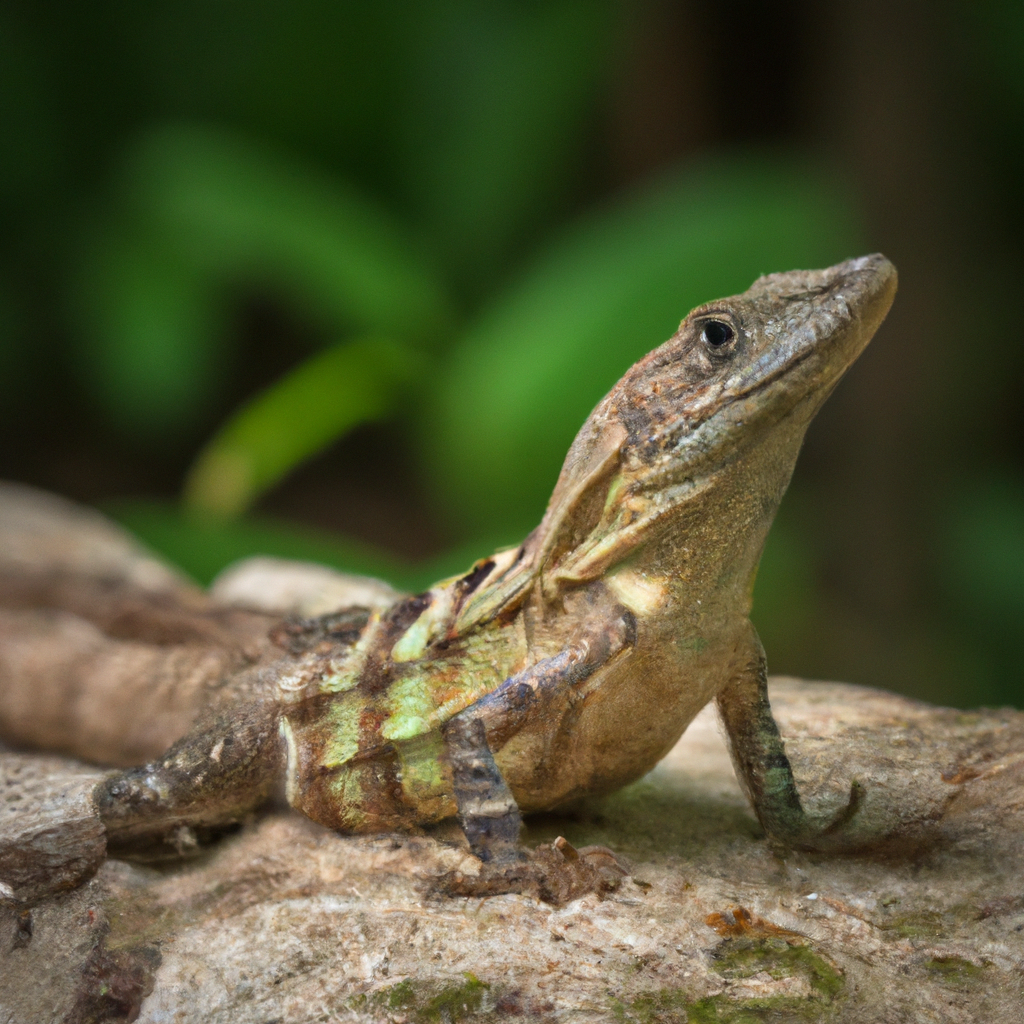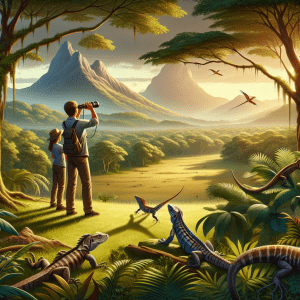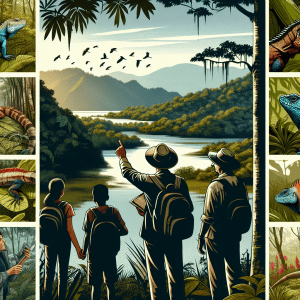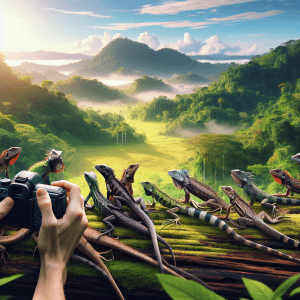Introduction to Lizard Diversity in Central America
Diving into the captivating world of lizard diversity across Central America is like embarking on a thrilling adventure filled with fascinating discoveries at every turn. Imagine strolling through lush rainforests, where the vibrant hues of various lizard species blend seamlessly with the verdant foliage around you. The sheer diversity of these reptiles is truly awe-inspiring, each one uniquely adapted to its environment.
Did you know that Central America is a hotspot for lizard biodiversity, boasting a rich array of species that call this region home? From the iconic green iguanas basking in the sun to the agile anoles darting among the branches, Central America offers a kaleidoscope of lizard life waiting to be explored.
As we delve deeper into the realm of lizard diversity in Central America, it becomes evident that these reptiles play a crucial role in maintaining the delicate balance of their ecosystems. Their presence as predators, prey, and seed dispersers contributes to the overall health and dynamics of the region’s biodiversity. It’s a complex web of interactions that underscores the interconnectedness of all living organisms in nature.
Now, picture yourself standing amidst a diverse landscape of habitats – from tropical rainforests to arid deserts – each providing a unique niche for different lizard species to thrive. Understanding the intricate relationship between these reptiles and their surroundings offers a glimpse into the remarkable adaptations and behaviors that have evolved over millennia.
So, why should we care about lizard diversity in Central America? Beyond their intrinsic beauty and ecological significance, these reptiles serve as indicators of environmental health and serve as ambassadors for conservation efforts in the region. By safeguarding their habitats and protecting their populations, we are not only preserving a vital component of Central America’s natural heritage but also ensuring a sustainable future for generations to come.
Importance of Lizards in the Ecosystem
Lizards might seem like just another critter crawling around, but did you know they play a crucial role in our ecosystem? It’s true! These scaly creatures are like tiny guardians, helping to keep the balance of nature in check. Imagine a world without lizards – insect populations might skyrocket, disrupting the delicate harmony of the environment.
Let me share a fascinating fact with you: lizards are essential in controlling insect populations. They are natural pest controllers, munching on bugs like ants, spiders, and even mosquitos. Without lizards around, these pesky insects could overrun our surroundings, causing chaos and discomfort for both humans and other animals.
Picture this: you’re enjoying a peaceful afternoon in your backyard when suddenly, a swarm of mosquitoes descends upon you. It’s a nightmare scenario, right? Well, thanks to lizards, this scenario is less likely to happen. These reptilian heroes help keep insect populations in check, reducing the chances of bug-related nuisances.
Now, think about the broader implications of lizard diversity in Central America. By understanding and appreciating the importance of these creatures, we can take steps to protect their habitats and ensure their continued presence in our ecosystem. Conservation efforts are vital in safeguarding the diverse species of lizards that call Central America home.
So, the next time you spot a lizard scurrying across your path, remember the crucial role they play in maintaining the delicate balance of nature. These seemingly small creatures have a big impact on our environment, making them worthy of our admiration and protection.
Overview of Different Lizard Species in Central America
When it comes to exploring the different lizard species in Central America, you’ll be amazed at the incredible diversity that exists within this region. From vibrant colors to unique adaptations, Central American lizards are truly fascinating creatures.
Let me share an interesting fact with you – did you know that Central America is home to over 300 species of lizards? Each of these species has its own distinct characteristics and behaviors, making them a crucial part of the region’s ecosystem. Some lizards, like the iconic green iguana, are known for their impressive size and ability to blend into their surroundings. Others, such as the colorful anoles, showcase a wide range of hues and patterns that help them camouflage and communicate with each other.
As we delve into the world of Central American lizards, you’ll discover how these fascinating creatures have adapted to thrive in various habitats across the region. From dense rainforests to arid deserts, lizards have found unique ways to survive and thrive in their environments. Their diverse diet preferences and hunting techniques also play a crucial role in maintaining the delicate balance of the ecosystem.
Exploring the different lizard species in Central America not only offers insights into their biology and behavior but also sheds light on the importance of conservation efforts to protect these remarkable creatures. With habitat loss and climate change posing significant challenges, it is essential to raise awareness about the conservation needs of Central American lizards.
So, are you ready to embark on a journey through the vibrant world of Central American lizards? Join me as we uncover the hidden wonders and incredible diversity of these captivating creatures that call this region home.
Habitat and Distribution of Central American Lizards
When it comes to the habitat and distribution of lizards in Central America, it’s truly a fascinating topic. Central America is a hotspot for biodiversity, and lizards play a crucial role in the region’s ecosystems. From lush rainforests to arid deserts, these scaly creatures have adapted to various environments, showcasing a remarkable diversity of species.
One interesting fact about the habitat and distribution of Central American lizards is their adaptability to different landscapes. For example, you can find the iconic green iguanas basking in the sun on tree branches in the tropical rainforests of Costa Rica, while the spiny-tailed iguanas roam the arid regions of Mexico and Honduras. Each species has evolved specific adaptations to thrive in their unique habitats, making them key indicators of environmental health.
Understanding the habitat preferences and distribution patterns of Central American lizards is essential for conservation efforts. By mapping out where different species are found and identifying their specific habitat requirements, researchers and conservationists can develop targeted strategies to protect these vulnerable populations. Climate change, habitat destruction, and illegal wildlife trade pose significant challenges to the survival of many lizard species in the region.
Conservation initiatives focus on preserving critical habitats, implementing regulations to combat illegal wildlife trade, and raising awareness about the importance of lizard diversity in Central America. By safeguarding these reptiles, we are not only protecting their populations but also maintaining the balance of diverse ecosystems they inhabit.
Next time you spot a lizard sunning itself on a rock or darting through the undergrowth, take a moment to appreciate the intricate relationship between these fascinating creatures and their environment. Their presence is a testament to the rich biodiversity of Central America and the ongoing efforts to ensure their survival for future generations.
Unique Characteristics and Behaviors of Central American Lizards
When it comes to the unique characteristics and behaviors of Central American lizards, there’s so much to uncover! Did you know that some lizards in this region have developed fascinating adaptations to survive in their diverse habitats? One interesting fact that always amazes me is how certain lizard species have the ability to change their skin color to blend in with their surroundings as a form of camouflage. It’s like they have their own built-in invisibility cloak!
Imagine encountering a lizard that can change from bright green to brown in a matter of seconds, perfectly matching the leaves or branches around it. This incredible ability not only helps them avoid predators but also aids them in hunting for food without being detected. It’s like witnessing a real-life magic trick in nature!
Aside from their camouflage skills, Central American lizards exhibit a wide range of behaviors that showcase their adaptability and survival instincts. Some species are known for their impressive climbing abilities, effortlessly scaling trees and rocks with agility. Others display intricate courtship rituals, using elaborate displays of color and movement to attract mates.
But here’s a thought-provoking question to ponder: How do these unique characteristics and behaviors contribute to the overall biodiversity of Central American ecosystems? By understanding the complexities of lizard diversity in this region, we gain insight into the intricate web of life that exists in these habitats. Each species plays a vital role in maintaining the balance of their ecosystem, from controlling insect populations to serving as prey for larger predators.
Exploring the world of Central American lizards not only offers a glimpse into the wonders of nature but also highlights the importance of preserving their habitats for future generations to appreciate. Next time you spot a lizard in the wild, take a moment to marvel at its unique features and remember the incredible diversity that thrives in the lush landscapes of Central America.
Conservation Challenges and Efforts for Lizard Diversity
Have you ever thought about the challenges that lizards face in maintaining their populations across Central America? It’s quite a complex issue, but one that is essential to address for the preservation of these unique creatures.
Imagine this – you’re a lizard living in the diverse habitats of Central America, from lush rainforests to arid deserts. While these environments offer a variety of niches for different lizard species to thrive, they also pose numerous challenges. Habitat destruction due to deforestation, urbanization, and climate change is a significant threat to many lizard populations. As their habitats shrink, lizards are forced to adapt or face extinction.
Conservation efforts play a crucial role in safeguarding the future of Central American lizards. Researchers and conservationists work tirelessly to study these reptiles, understand their needs, and implement strategies to protect their habitats. From establishing protected areas to raising awareness about the importance of lizard diversity, every effort counts in ensuring these fascinating creatures continue to exist.
One interesting fact to note is that some lizard species have evolved unique adaptations to survive in their changing environments. For instance, the green iguana, found in Central America, can change its color to blend in with its surroundings, offering camouflage from predators. These remarkable adaptations showcase the resilience and ingenuity of lizards in the face of adversity.
So, here’s a thought-provoking question for you: How can we, as individuals, contribute to the conservation of lizard diversity in Central America? Whether it’s supporting conservation organizations, advocating for sustainable practices, or simply spreading awareness about the importance of biodiversity, our actions can make a difference in protecting these incredible creatures for future generations to appreciate.
By understanding the conservation challenges and efforts surrounding lizard diversity in Central America, we can all play a part in ensuring the survival and well-being of these remarkable reptiles.
Interesting Facts about Central American Lizards
Have you ever heard about the incredible regenerative abilities of some lizard species found in Central America? It’s mind-blowing! Imagine if humans had the power to regrow lost limbs or tails like certain lizards do. That would certainly make life a lot more interesting, wouldn’t it?
These remarkable lizards have the unique ability to regenerate their tails when they are detached or lost. This process, known as autotomy, allows them to detach their tails as a defense mechanism against predators and then regrow a new one over time. It’s like having a built-in superhero power!
But here’s the fascinating part – not only do these lizards regrow their tails, but the new tail that grows back is often slightly different from the original one. The regenerated tail may have a different color, pattern, or scale structure, making it a fascinating aspect of their biology.
This regenerative ability not only helps the lizards escape from predators but also plays a crucial role in their survival and overall health. It’s like a natural superpower that these amazing creatures possess, showcasing the incredible adaptability of nature.
Just imagine if humans had the same regenerative capabilities as these lizards. It could revolutionize the field of medicine and change the way we approach healing and recovery from injuries. The study of lizard regeneration offers valuable insights into tissue regeneration and has the potential to inspire new advancements in regenerative medicine.
So, the next time you come across a lizard in Central America, take a moment to appreciate the extraordinary regenerative powers they possess. It’s a reminder of the wonders of the natural world and the endless possibilities that nature has to offer.
Appreciating the Rich Biodiversity of Lizards in Central America
Have you ever stopped to consider the incredible adaptations that Central American lizards have developed over time? It’s truly fascinating to explore the unique features and behaviors of these creatures that allow them to thrive in diverse environments. Let me share an interesting fact with you – did you know that some species of Central American lizards can change their skin color to blend in with their surroundings? It’s like having a built-in camouflage suit!
This ability to change color not only helps them evade predators but also aids in hunting for prey. Imagine being able to transform your appearance based on your surroundings – it’s like having a superpower! This adaptive trait showcases the remarkable evolution that has taken place within these lizard populations over generations.
As we delve deeper into the world of Central American lizards, it’s essential to recognize the broader significance of their biodiversity. These creatures play a crucial role in maintaining the balance of their ecosystems by controlling insect populations, dispersing seeds, and serving as a food source for other animals. Their presence is intricately woven into the intricate web of life in Central America.
So, the next time you spot a lizard basking in the sun or scurrying across the forest floor, take a moment to appreciate the beauty of their existence and the vital role they play in the natural world. Their diversity is not just a matter of species variety but a reflection of the intricate relationships that sustain the rich tapestry of life in Central America. Let’s continue to marvel at the wonders of nature and strive to protect and preserve the diverse lizard species that call this region home.




